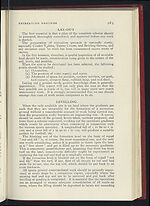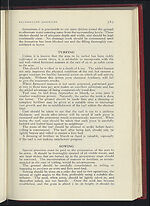1938-39
(618)
Download files
Complete book:
Individual page:
Thumbnail gallery: Grid view | List view

I
9,
1
F.
5
8
4
RECREATION GROUNDS
12
ins. deep. The sections of the work must be so ordered to avoid
any prolonged stacking of turf before re-laying.-
Care should be taken to ensure that all available top soil is evenly
spread over the entire area, and where it is of a heavy nature the
physical condition can be improved by the addition of
10
to
20
per
cent. of screened boiler ashes or sharp sand.
DRAINING
It is, of course, impossible to lay down any hard and fast rules
on draining. The advice of a qualified expert, who is accustomed
to recreation ground work, should be sought ; so often it is learned
that the local farmer has been consulted. Draining farm land and
recreation grounds are very different subjects.
The agricultural drain pipes used in draining. farm land are
usually laid
2
ft. 6 ins. to 4 ft. under the ground level, as there is
not the necessity for the ground drying up immediately. It is, in
fact, advantageous that a certain amount of moisture should remain.
Again, the pipes must be laid at such a depth to safeguard them
from possible damage which might be caused by the cultivation
of land with up-to-date farm implements.
What is required for recreation ground purposes is that any
water or moisture laying on the surface will readily be absorbed, so
that the ground- will not churn up and become a quagmire when
used for football and other games.
If the land is of a very heavy nature, then the intermediate
drains should be laid at i o ft. to
12
ft. centres.
The depth of the drain track should not be more than
18
ins. ;
6 ins. wide at the bottom and 9 ins. at the top, and agricultural
drain pipes 3 ins. in diameter is the minimum size recommended for
laying in the tracks.
The pipes should be covered with sharp clinker, ash, gravel,
hardcore, or any other suitable material, to within 9 ins. of the.
top, the best of the available top soil being replaced on top. If this
is very heavy, fine ash or other suitable material should be in-
corporated, to ensure porosity, otherwise the water that it is desired
to clear quickly will not easily get away.
Main drains should consist of 4-in. to 6-in. agricultural drain
pipes, laid in tracks averaging
18
ins. to
24
ins. in depth, 9 ins. wide
at the bottom and
12
ins. at the top, and covered as already described.
Suitable outfalls of the main drains must be one of the chief
considerations in conceiving any particular scheme.
The cutting of drain tracks to perfect alignment should be
carried out most carefully, and they should be bottomed to even
gradients.
Land which is not of a very heavy or clayey nature should be
successfully dealt with if the intermediate drains are laid at i
5
ft.
centres, and in some cases as far apart as
20
ft. centres, but it may
be safely assumed that the draining of a ground at greater intervals
than these will not produce satisfactory results, owing to the in-
adequate drawing power.
9,
1
F.
5
8
4
RECREATION GROUNDS
12
ins. deep. The sections of the work must be so ordered to avoid
any prolonged stacking of turf before re-laying.-
Care should be taken to ensure that all available top soil is evenly
spread over the entire area, and where it is of a heavy nature the
physical condition can be improved by the addition of
10
to
20
per
cent. of screened boiler ashes or sharp sand.
DRAINING
It is, of course, impossible to lay down any hard and fast rules
on draining. The advice of a qualified expert, who is accustomed
to recreation ground work, should be sought ; so often it is learned
that the local farmer has been consulted. Draining farm land and
recreation grounds are very different subjects.
The agricultural drain pipes used in draining. farm land are
usually laid
2
ft. 6 ins. to 4 ft. under the ground level, as there is
not the necessity for the ground drying up immediately. It is, in
fact, advantageous that a certain amount of moisture should remain.
Again, the pipes must be laid at such a depth to safeguard them
from possible damage which might be caused by the cultivation
of land with up-to-date farm implements.
What is required for recreation ground purposes is that any
water or moisture laying on the surface will readily be absorbed, so
that the ground- will not churn up and become a quagmire when
used for football and other games.
If the land is of a very heavy nature, then the intermediate
drains should be laid at i o ft. to
12
ft. centres.
The depth of the drain track should not be more than
18
ins. ;
6 ins. wide at the bottom and 9 ins. at the top, and agricultural
drain pipes 3 ins. in diameter is the minimum size recommended for
laying in the tracks.
The pipes should be covered with sharp clinker, ash, gravel,
hardcore, or any other suitable material, to within 9 ins. of the.
top, the best of the available top soil being replaced on top. If this
is very heavy, fine ash or other suitable material should be in-
corporated, to ensure porosity, otherwise the water that it is desired
to clear quickly will not easily get away.
Main drains should consist of 4-in. to 6-in. agricultural drain
pipes, laid in tracks averaging
18
ins. to
24
ins. in depth, 9 ins. wide
at the bottom and
12
ins. at the top, and covered as already described.
Suitable outfalls of the main drains must be one of the chief
considerations in conceiving any particular scheme.
The cutting of drain tracks to perfect alignment should be
carried out most carefully, and they should be bottomed to even
gradients.
Land which is not of a very heavy or clayey nature should be
successfully dealt with if the intermediate drains are laid at i
5
ft.
centres, and in some cases as far apart as
20
ft. centres, but it may
be safely assumed that the draining of a ground at greater intervals
than these will not produce satisfactory results, owing to the in-
adequate drawing power.
Set display mode to:
![]() Universal Viewer |
Universal Viewer | ![]() Mirador |
Large image | Transcription
Mirador |
Large image | Transcription
| Games and sports in the army > 1938-39 > (618) |
|---|
| Permanent URL | https://digital.nls.uk/248744640 |
|---|
| Description | 'Games and Sports in the Army' was an annual publication produced by the British War Office between the 1930s and 1960s. This included the Second World War. It outlines the rules and regulations for games and sports played by members of the armed forces. It features names and photographs of team members, and examples of contemporary advertising. |
|---|---|
| Shelfmark | GWB.52 |

